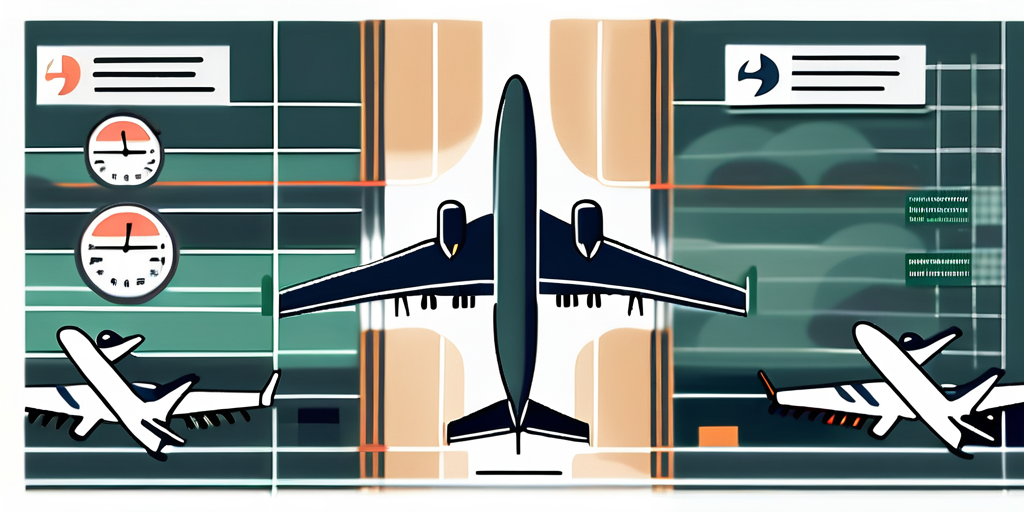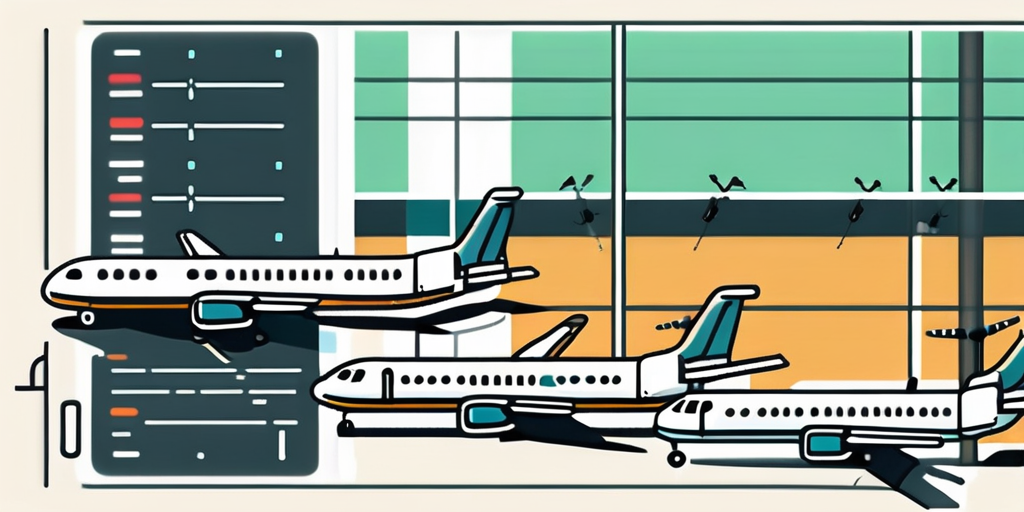Flight Delay Statistics: A Comprehensive Analysis of Delays in Air Travel
Discover insightful flight delay statistics. Gain a deeper understanding of travel disruptions and trends to better plan your journeys.
Flight delays are an unfortunate but common occurrence in air travel. Understanding the causes and impact of these delays is crucial for both airlines and passengers. In this article, we will delve into the flight delay statistics and provide a comprehensive analysis of delays in air travel.
Understanding Flight Delays
Flight delays can be frustrating and inconvenient for travelers. There are various factors that contribute to these delays, ranging from weather conditions to airline operations. By understanding the causes, we can better evaluate the impact and identify strategies for minimizing delays.

Causes of Flight Delays
Airline delays can stem from multiple sources. Weather conditions, such as thunderstorms or heavy fog, often disrupt flight schedules. These natural phenomena can create unsafe flying conditions, forcing airlines to delay or cancel flights in the interest of passenger safety. While airlines strive to minimize the impact of weather-related delays, it is important to remember that safety is their top priority.
In addition to weather, mechanical issues with the aircraft can also lead to delays. Airlines have rigorous maintenance programs in place to ensure the safety and reliability of their fleet. However, unexpected mechanical problems can arise, requiring the aircraft to undergo repairs before it can take off. While these delays are frustrating, they are necessary to ensure the safety of passengers and crew.
Crew scheduling problems can also contribute to flight delays. Airlines have to carefully manage their crew's working hours and rest periods to comply with regulations and ensure their well-being. Sometimes, unforeseen circumstances like illness or last-minute changes in flight schedules can disrupt crew availability, leading to delays. Airlines work diligently to address these issues and minimize their impact on passengers.
Another factor that can cause flight delays is air traffic congestion. Airports, especially major hubs, can experience heavy traffic, leading to delays in takeoff and landing. Air traffic control systems work tirelessly to manage the flow of aircraft, but sometimes the volume of flights exceeds capacity, resulting in delays. Efforts are continuously being made to improve air traffic management and reduce congestion, but it remains a challenge in busy airspace.
The Impact of Flight Delays on Travelers
Flight delays can have a significant impact on travelers. It can result in missed connections, missed events, and added expenses due to accommodation or transportation arrangements. Imagine a traveler who has meticulously planned their trip, only to find themselves stranded at an airport due to a delay. They may miss an important business meeting, a family gathering, or a once-in-a-lifetime opportunity. These missed opportunities can be emotionally and financially distressing.
Moreover, delays may lead to increased stress and decreased customer satisfaction. Waiting for hours at an airport, uncertain about when the flight will depart, can be incredibly frustrating. Passengers may feel anxious, tired, and inconvenienced. Airlines understand the negative impact of delays on their customers and strive to provide timely updates, assistance, and compensation when appropriate.
Understanding the impact of flight delays helps both airlines and passengers in managing delays effectively. Airlines can use this knowledge to improve their operations, implement better contingency plans, and invest in technologies that minimize disruptions. Passengers, on the other hand, can plan their trips more wisely, consider travel insurance, and stay informed about their rights and entitlements in case of delays. By working together, airlines and travelers can navigate the challenges of flight delays and make the travel experience as smooth as possible.
The Data Behind Flight Delays
Analyzing flight delay trends is crucial for airlines to identify patterns and make informed decisions. By studying historical data, airlines can better predict potential delays and allocate necessary resources.
Analyzing Flight Delay Trends
Through data analysis, airlines can identify trends in flight delays. This includes identifying peak delay periods and understanding the specific routes or airports that are prone to delays. By examining these trends, airlines can implement proactive measures to mitigate delays.
The Role of Weather in Flight Delays
Weather conditions play a significant role in flight delays. Adverse weather, such as storms or heavy snowfall, can lead to cancellations and delays. Airlines need to closely monitor weather patterns and have contingency plans in place to minimize disruptions caused by weather-related delays.
Another factor that contributes to flight delays is air traffic congestion. As more and more people choose air travel as their preferred mode of transportation, airports become busier, leading to increased air traffic. This congestion can result in delays as planes are required to wait for their turn to take off or land. Airlines must work closely with air traffic control to manage the flow of aircraft and minimize delays caused by congestion.
In addition to weather and air traffic congestion, mechanical issues can also cause flight delays. Aircraft are complex machines that require regular maintenance and inspections. If a mechanical issue is identified during pre-flight checks or while the plane is in operation, it may need to be grounded for repairs. This can result in delays as the airline works to resolve the issue and ensure the safety of the passengers and crew.
- Almost 78% of the flights were on time.
- 7.38% of the delay come from the aircraft arriving late.
- 6.78% of the delays come from the air carrier.
- 5.22% is due to a national aviation system delay.
- Weather issues only represent 0.68% of the delays in the US.
- 1.29% of the flights were cancelled
- 0.24% of the flights were diverted
- 0.06% of the national flight delay is due to the security.
The Most Affected Airports by Delays
Airport delays can vary significantly depending on the location and infrastructure. Some airports are more prone to delays due to factors such as air traffic, weather conditions, or inadequate facilities. Understanding the factors contributing to airport delays helps both airports and passengers devise effective strategies.

Let's take a closer look at some of the factors that contribute to airport delays. One major factor is outdated infrastructure. Many airports around the world were built decades ago and have not kept up with the rapid growth in air travel. This can lead to congestion on runways, taxiways, and terminals, resulting in delays for departing and arriving flights.
Another factor is limited runway capacity. As air travel continues to increase, some airports find themselves struggling to accommodate the growing number of flights. This can lead to longer wait times for planes to take off or land, causing delays for passengers.
Additionally, high air traffic volume is a significant contributor to airport delays. Popular airports that serve as major hubs for multiple airlines often experience heavy traffic, especially during peak travel seasons. The sheer number of flights coming in and out of these airports can overwhelm the existing infrastructure, leading to delays.
Factors Contributing to Airport Delays
Airports experience delays due to various factors. These include outdated infrastructure, limited runway capacity, and high air traffic volume. By identifying these factors, airports can invest in necessary upgrades and collaborate with authorities to improve efficiency.
Recognizing the challenges posed by these factors, airports have been implementing strategies to minimize delays and improve overall efficiency. One such strategy is optimizing runway scheduling. By carefully planning and coordinating the arrival and departure times of flights, airports can reduce the likelihood of congestion and delays.
Another strategy is the implementation of advanced air traffic control systems. These systems use cutting-edge technology to monitor and manage air traffic, ensuring that planes are safely and efficiently guided through the airspace. By improving communication and coordination between pilots and air traffic controllers, delays can be minimized.
Furthermore, airports are focusing on improving ground operations to minimize delays. This includes streamlining the processes for baggage handling, security checks, and aircraft servicing. By enhancing the efficiency of these operations, airports can reduce the time it takes for planes to prepare for departure or arrival, ultimately reducing delays.
Strategies for Minimizing Airport Delays
To minimize airport delays, airports can employ various strategies. This includes optimizing runway scheduling, implementing advanced air traffic control systems, and improving ground operations. By adopting these strategies, airports can enhance overall efficiency and reduce delays.
It is important for airports to continuously assess and address the factors contributing to delays. By investing in infrastructure upgrades, collaborating with authorities, and implementing effective strategies, airports can strive to provide a smoother travel experience for passengers and maintain their position as key transportation hubs.
The Economic Impact of Flight Delays
Flight delays not only affect passengers but also have significant economic implications for both airlines and the travel industry as a whole. Understanding the cost of delays is crucial for airlines to devise effective measures and minimize financial losses.
Cost of Delays to Airlines
Airlines face substantial financial losses due to flight delays. These include additional fuel costs, crew expenses, and compensation to passengers. By quantifying the cost of delays, airlines can determine the feasibility of implementing measures to minimize disruptions.
Cost of Delays to Passengers
Flight delays can result in added costs for passengers, including missed connections, accommodation expenses, and rescheduling fees. By understanding the financial burden imposed on passengers, airlines can develop customer-centric solutions and improve overall satisfaction.
In conclusion, flight delay statistics provide valuable insights into the causes, impact, and economic implications of delays in air travel. By analyzing these statistics, airlines and airports can devise strategies to minimize disruptions and enhance the travel experience for passengers. Additionally, passengers can make informed decisions based on delay trends and airline performance, ensuring a smoother and more enjoyable journey.
Get the Compensation You Deserve with ClaimCompass
Flight delays are more than just a nuisance—they can be costly. If you've experienced a delay, cancellation, or overbooking on your European travels, ClaimCompass is here to help. We specialize in securing up to 600€ in compensation for air passengers, leveraging EU Regulation 261/2004 to determine your eligibility. Don't let the airlines keep what you're owed !
With our free flight delay compensation calculator, learn whether you're eligible for compensation and how much the airline may owe you, in just 2 minutes.
What percent of flights get delayed?
The percentage of flights that get delayed varies depending on various factors such as airline, route, time of year, and external factors like weather and air traffic control. However, on average, a significant portion of flights experience some form of delay.
According to data from the U.S. Department of Transportation (DOT) and the Federal Aviation Administration (FAA), in recent years, approximately 20-25% of flights in the United States have been delayed. These delays can range from a few minutes to several hours and can be caused by factors such as mechanical issues, crew scheduling problems, airport congestion, or adverse weather conditions.
What is the most common cause of flight delays?
According to the United States Department of Transportation, in 2023 - 7.38% of the delay come from the aircraft arriving late, being the main reason for delay. - 6.78% of the delays come from the air carrier. - 5.22% is due to a national aviation system delay. - Weather issues only represent 0.68% of the delays in the US. - 1.29% of the flights were cancelled - 0.24% of the flights were diverted - 0.06% of the national flight delay is due to the security.
How long is the average flight delay?
The average flight delay can vary significantly depending on factors such as the airline, route, time of year, and the specific circumstances of the delay. However, on average, flight delays tend to range from a few minutes to several hours.
According to data from the U.S. Department of Transportation (DOT) and other aviation authorities, the average duration of flight delays can be broken down as follows:
- Minor Delays: These delays typically last less than 15 minutes and may be caused by factors such as minor air traffic congestion, slight scheduling adjustments, or brief runway closures.
- Moderate Delays: Moderate delays generally range from 15 minutes to 2 hours and may result from factors such as weather-related disruptions, aircraft maintenance issues, or air traffic control restrictions.
- Significant Delays: Significant delays can last from 2 hours to 4 hours or more and are often caused by more severe weather events, mechanical problems requiring extensive repairs, or air traffic congestion at busy airports.
- Cancellations: In some cases, flights may be canceled altogether rather than delayed, particularly if the delay is expected to be lengthy or if the airline determines that it is not feasible to operate the flight.
Do airlines compensate for flight delays?
Yes, they do. To be eligible, however, the airline must be responsible for the delay.
If the flight was disrupted because of extraordinary circumstances, such as air traffic control restrictions, adverse weather conditions, or security risks at the airport, then the airline is not obligated to compensate passengers.
You need to arrive at your final destination at least 3 hours late to claim a compensation for your delayed flight.
Note that it's the delay at arrival that matters (not the delay at departure): for example, if your flight departed 3h15 late, but caught up on the delay during the flight and arrived "only" 2h58 late, then you are not eligible to a compensation.
If your journey includes a connection and the first flight is delayed but you still arrive at your final destination less than 3 hours late, you are not entitled to a compensation either.
